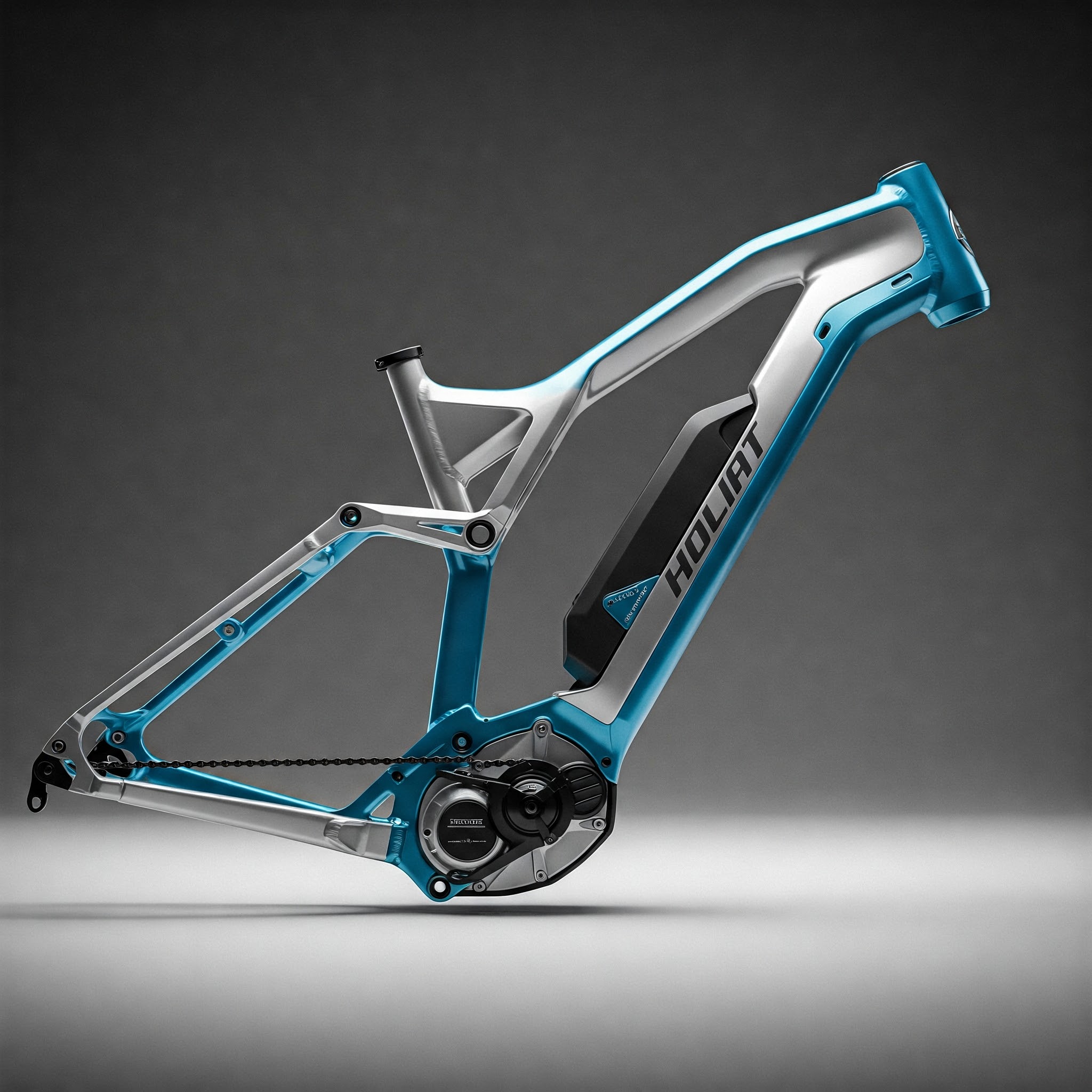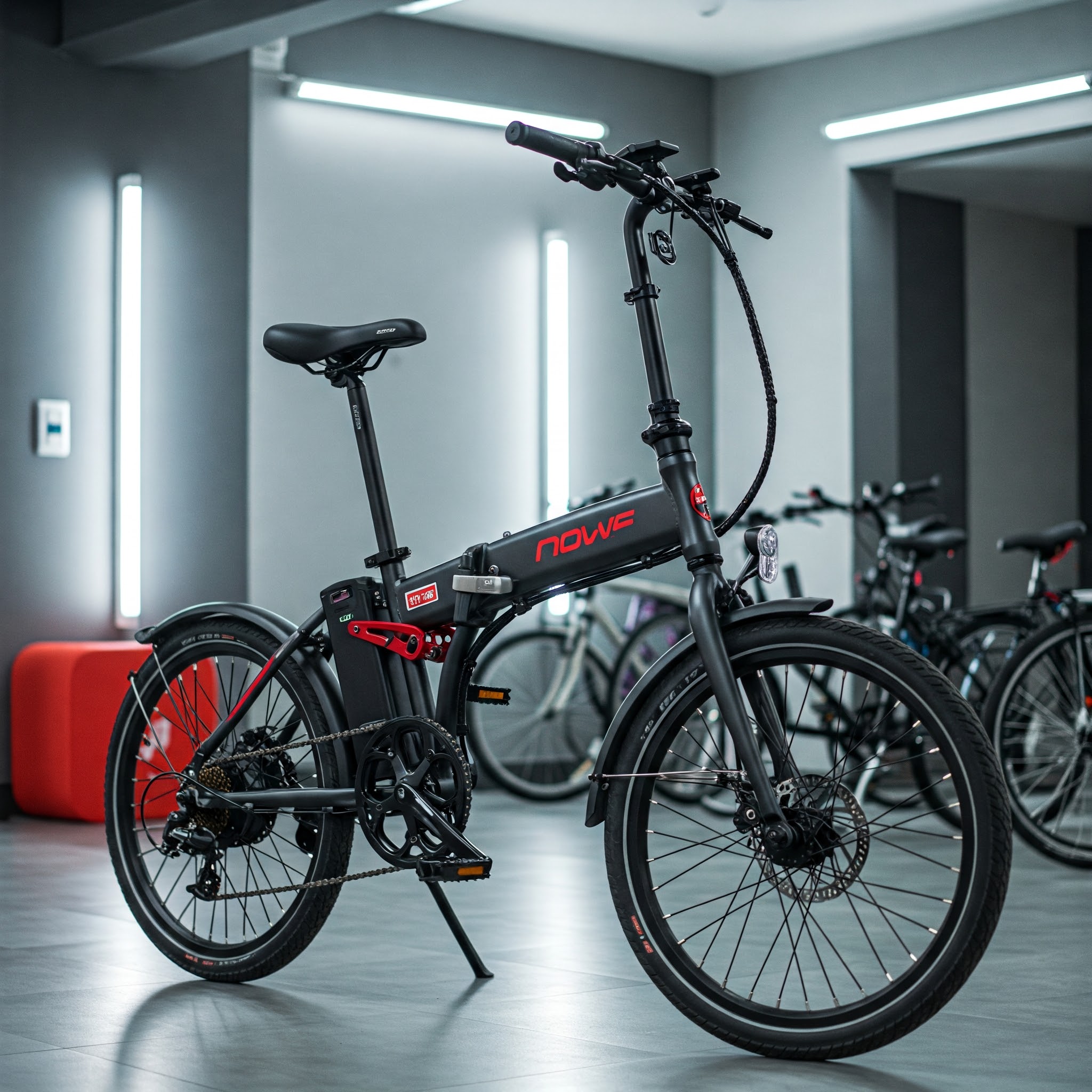In the rapidly evolving world of electric bicycles, the frame serves as both the backbone and defining characteristic of your riding experience. As e-mobility continues to reshape transportation, understanding the nuances of electric bike frame design becomes increasingly important for both casual riders and enthusiasts alike. The frame of an electric bike isn’t just a structural component—it’s the foundation that determines comfort, performance, and durability of your electric riding experience.
✨Was this helpful? Spread the word! 🚀
Electric bike frames have undergone significant evolution over the past decade, with manufacturers developing specialized designs that accommodate battery systems, motors, and the unique stress patterns experienced during powered riding. Unlike traditional bicycle frames, an electric bike frame must balance additional considerations like weight distribution, motor placement, and battery integration while maintaining structural integrity and ride quality.
The market for electric bike frame options has expanded dramatically, with designs now specifically engineered for various riding styles, from comfortable cruising to aggressive off-road adventures. Whether you’re looking for your first e-bike or considering an upgrade, understanding frame materials, geometries, and designs will help you make an informed decision that matches your riding preferences and practical needs.
Comparing Electric Bike Frames with Traditional Bicycle Frames
| Feature | Electric Bike Frame | Traditional Bicycle Frame |
|---|---|---|
| Weight | Typically heavier (3-8 lbs more) | Lighter construction |
| Design Considerations | Must accommodate battery, motor, wiring | Focused primarily on rider biomechanics |
| Stress Points | Enhanced reinforcement at motor mount, battery attachment | Traditional stress distribution |
| Material Requirements | Often uses thicker tubing for added support | Standard tubing thickness |
| Price Range | $300-$2,000+ (frame only) | $150-$1,500+ (frame only) |
| Integration Features | Cable routing, battery housing, controller mounts | Basic cable routing only |
| Frame Geometry | Often modified for stability with added power | Optimized for human power only |
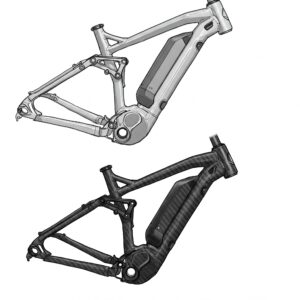
In today’s comprehensive guide, we’ll explore everything you need to know about electric bike frames—from materials and construction techniques to design considerations and top recommendations for different riding styles. By the end of this article, you’ll have the knowledge to choose the perfect electric bike frame for your specific needs, budget, and performance expectations.
Understanding Electric Bike Frame Basics
The foundation of any quality electric bicycle begins with its frame. An electric bike frame differs significantly from standard bicycle frames due to several key factors that accommodate the additional components required for powered assistance.
What Makes Electric Bike Frames Different?
Electric bike frames are specifically designed to handle the unique demands of motorized cycling. The primary differences include:
🔋 Battery Integration – Quality e-bike frames feature dedicated mounting points or internal compartments for battery placement. The position of these mounts significantly affects weight distribution and handling.
⚡ Motor Housing – Whether mid-drive or hub-driven, electric bike frames require reinforced areas to securely mount motors and withstand the additional torque they generate.
🔌 Cable Management – E-bike frames include internal or protected routing channels for the electrical connections between battery, controller, motor, and display units.
🏋️♂️ Reinforced Construction – The additional weight and forces exerted on electric bike frames necessitate stronger tubing, reinforced joints, and sometimes completely different geometries from traditional bicycles.
🛠️ Integration Points – Modern e-bike frames often include mounting points for accessories like controllers, displays, lights, and sensors that are powered by the main battery system.
E bike frame design has evolved considerably, with manufacturers now offering purpose-built options rather than simply adapting traditional bicycle frames. This evolution has led to more efficient, comfortable, and durable electric bikes across all categories.
Common Electric Bike Frame Styles
When shopping for an electric bicycle, you’ll encounter several distinct frame styles, each with unique advantages:
1. Diamond/Triangle Frame
The classic bicycle design adapted for electric components, offering excellent structural strength and familiar handling characteristics. This traditional design remains popular for its versatility and proven performance.
2. Step-Through Frame
A frame design with a lowered or absent top tube, making mounting and dismounting significantly easier—particularly beneficial for riders with mobility limitations or those who frequently stop in urban environments. E bike frame designs in this category prioritize accessibility without compromising structural integrity.
3. Folding Frame
Compact frames with hinges that allow the bike to fold for storage or transport. These electric bike frame types are ideal for commuters with limited storage space or those who combine cycling with public transportation.
4. Cargo Frame
Reinforced frames with extended wheelbases designed to carry heavy loads. These specialized electric bike frames typically feature strengthened tubing and additional mounting points for racks and accessories.
5. Full-Suspension Frame
Performance-oriented frames with front and rear suspension systems, designed for off-road riding or maximum comfort on rough terrain. These advanced frames require careful engineering to accommodate both suspension components and electric drive systems.
6. Low-Step Frame
A variation of step-through designs with a slightly higher top tube, offering a balance between accessibility and frame rigidity. This compromise makes low-step frames popular for urban commuters of all ages.
Electric Bike Frame Materials
The material composition of an electric bike frame dramatically influences its performance characteristics, durability, and price point. Let’s explore the most common materials used in today’s market:
Aluminum Alloy
By far the most prevalent material for electric bike frames, aluminum offers an excellent balance of weight, strength, and cost-effectiveness. Modern aluminum e bike frames utilize various alloys like 6061 and 7005, each providing slightly different ride characteristics.
✅ Advantages:
- Lightweight compared to steel
- Naturally corrosion-resistant
- Relatively affordable
- Good strength-to-weight ratio
- Easy to manufacture in complex shapes
❌ Disadvantages:
- Can provide a stiffer ride than some materials
- Potentially shorter fatigue life than steel
- Repair can be more difficult if damaged
- Not as environmentally sustainable as some alternatives
Aluminum remains the standard choice for most electric bike frames across all price points due to its versatility and cost-effectiveness. Many manufacturers enhance aluminum frames with hydroforming techniques to create more aerodynamic and aesthetically pleasing tube shapes.
Carbon Fiber
Reserved primarily for premium electric bicycles, carbon fiber composite frames offer exceptional strength while maintaining minimal weight. Carbon frames allow designers to create optimized shapes that would be impossible with metal tubing.
✅ Advantages:
- Extremely lightweight
- Can be shaped for aerodynamic efficiency
- Absorbs vibration better than aluminum
- Customizable stiffness in different frame areas
- High strength-to-weight ratio
❌ Disadvantages:
- Significantly more expensive
- Can be damaged from impacts that wouldn’t harm metal frames
- Difficult to inspect for internal damage
- Manufacturing process is less environmentally friendly
- More costly to repair if damaged
Carbon fiber electric bike frames are typically found on high-performance models where weight savings and ride quality justify the additional cost. The material’s ability to be molded into aerodynamic shapes also makes it popular for speed-focused e-bikes.
Steel
Traditional and dependable, steel frames offer exceptional durability and a distinctive, comfortable ride quality. While heavier than aluminum, quality steel tubing provides excellent vibration dampening and legendary longevity.
✅ Advantages:
- Exceptionally durable
- Provides a comfortable, compliant ride
- Easier to repair than other materials
- Excellent fatigue resistance
- Time-tested reliability
❌ Disadvantages:
- Heavier than aluminum or carbon fiber
- Susceptible to rust if not properly treated
- Less common in modern electric bikes
- Less efficient for energy use due to weight
Steel electric bike frames often appeal to traditionalists and those seeking maximum durability and comfort. The material’s natural flex characteristics can create a more comfortable ride on rough surfaces, though the weight penalty is significant for electric bikes where efficiency is important.
Titanium
The exotic choice for premium electric bike frames, titanium offers a unique combination of lightweight construction, exceptional durability, and superior ride quality. Though rare due to cost constraints, titanium frames provide unmatched longevity.
✅ Advantages:
- Excellent strength-to-weight ratio
- Naturally corrosion-resistant
- Provides comfortable ride characteristics
- Extremely long-lasting
- Prestigious material with distinctive appearance
❌ Disadvantages:
- Prohibitively expensive for most consumers
- Requires specialized manufacturing techniques
- Limited availability in electric bike market
- Challenging to repair if damaged
Titanium electric bike frames represent the pinnacle of metal frame construction, combining many benefits of both steel and aluminum without their respective disadvantages—aside from cost. Titanium’s natural corrosion resistance makes it particularly well-suited for all-weather electric bicycles.
Magnesium
An emerging material in the electric bike frame market, magnesium alloy offers excellent dampening properties and light weight. While less common than aluminum, magnesium frames are gaining popularity in certain segments of the market.
✅ Advantages:
- Lighter than aluminum
- Superior vibration absorption
- Good thermal conductivity
- Potentially recyclable
- Distinctive appearance
❌ Disadvantages:
- More expensive than aluminum
- More susceptible to corrosion
- Less common in the market
- Limited design options currently available
Magnesium remains an intriguing alternative for electric bike frames, particularly for riders seeking maximum comfort without the weight penalty of steel. The material’s excellent dampening characteristics make it well-suited for urban commuter e-bikes.
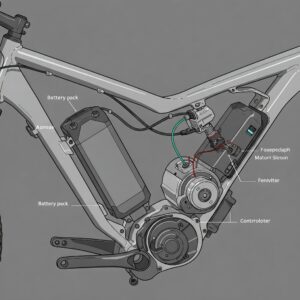
Key Design Considerations for Electric Bike Frames
When evaluating electric bike frames, several design factors significantly impact performance, comfort, and utility. Understanding these elements will help you select the perfect e bike frame for your specific needs.
Battery Integration Methods
The approach to battery placement represents one of the most critical design decisions in electric bike frame construction:
Integrated/Internal Battery
Modern premium electric bike frames often feature batteries concealed within the frame tubes themselves, typically in the downtube. This approach offers:
- Improved aesthetics with a cleaner look
- Better weight distribution and center of gravity
- Enhanced protection from elements and impacts
- Potential aerodynamic advantages
- More difficult battery access for charging/replacement
The Specialized Turbo Vado SL exemplifies this approach with its sleek downtube-integrated battery that maintains the bike’s clean lines while protecting the power source from environmental factors.
External/Mounted Battery
Many electric bike frames utilize externally mounted batteries, typically attached to the downtube or rear rack:
- Easier battery removal for charging
- Simplified replacement when battery life diminishes
- Generally less expensive manufacturing
- More visible appearance
- Greater vulnerability to elements
- Potential impact on weight distribution
The Rad Power RadRover 6 Plus uses this approach with its semi-integrated downtube battery that maintains good accessibility while still looking reasonably streamlined.
Motor Mounting Options
The location of the motor fundamentally changes how an electric bike frame must be designed:
Mid-Drive Systems
These motors are positioned at the bottom bracket area, requiring specially designed frames with reinforced bottom bracket shells and often proprietary mounting systems.
- Centralizes weight for better handling
- Allows use of standard wheels
- Typically more efficient power transfer
- Requires specific frame design
- Often more expensive construction
The Bosch Performance Line CX motor system requires frames specifically engineered with their mounting pattern and clearances, exemplified by bikes like the Trek Rail 9.8.
Hub-Drive Systems
Motors located in either wheel hub (usually rear) place different stress on electric bike frames:
- Simpler frame design requirements
- Often more affordable
- Greater unsprung weight impacts ride quality
- Requires specialized dropout design for rear hub motors
- Torque arms often needed for structural integrity
The Aventon Pace 500 features a rear hub motor design with reinforced rear dropouts to handle the additional torque generated during acceleration.
Frame Geometry Considerations
The angles and measurements that define an electric bike frame dramatically impact handling, comfort, and efficiency:
Head Tube Angle
This angle influences steering response and stability:
- Steeper angles (73-74°) provide quicker handling but less stability
- Slacker angles (66-71°) increase stability, particularly at higher speeds
Electric bike frames often use slightly slacker head tube angles than comparable traditional bikes to enhance stability at motor-assisted speeds.
Wheelbase
The distance between wheel centers affects stability and maneuverability:
- Longer wheelbases provide greater stability but less agility
- Shorter wheelbases improve maneuverability but can feel twitchy at speed
Many e bike frame designs extend the wheelbase slightly to improve stability under power and provide more room for battery integration.
Bottom Bracket Height
This measurement impacts stability and pedal clearance:
- Lower bottom brackets improve stability but reduce pedal clearance
- Higher bottom brackets offer better obstacle clearance but can feel less stable
Electric mountain bike frames often feature higher bottom brackets to maintain clearance when navigating obstacles with the additional weight of motor and battery.
Stack and Reach
These measurements define the frame’s vertical and horizontal dimensions, directly impacting rider comfort:
- Higher stack and shorter reach create a more upright, comfortable position
- Lower stack and longer reach produce a more aggressive, aerodynamic position
Many urban electric bike frames feature higher stack measurements to promote comfortable upright riding positions for better visibility in traffic.

Specialized Frame Features for Different Riding Styles
Electric bike frames are increasingly designed for specific riding applications, with features optimized for particular uses:
Urban Commuter Frames
City-focused electric bike frames prioritize practical features:
🚲 Integrated Lighting Mounts – Frame-integrated mounts for headlights and taillights, often wired directly to the main battery
🔒 Security Features – Some premium urban e bike frames include integrated locks or security tracking devices
📱 Tech Integration – Mounts or internal routing for smart displays, GPS units, and smartphone connectivity
🧳 Cargo Capacity – Reinforced attachment points for racks, baskets, and panniers
🛡️ Fender Mounts – Dedicated attachments for full-coverage fenders to keep riders clean in all weather
The Cannondale Mavaro Neo demonstrates these urban-specific frame features with its integrated lighting system, fender mounts, and rack compatibility.
Off-Road/Mountain Bike Frames
Electric mountain bike frames require specialized design elements:
🏔️ Suspension Integration – Specially designed linkage systems that accommodate motor and battery components
💪 Reinforced Construction – Thicker tubing and gussets at high-stress areas to handle off-road impacts
🌊 Water Resistance – Enhanced sealing around electrical component junctions for muddy conditions
👟 Wider Clearances – Additional space for larger tires and mud shedding
🔋 Protected Battery Placement – Strategic positioning to prevent damage during crashes or impacts
The Santa Cruz Heckler exemplifies purpose-built electric mountain bike frame design with its full-suspension system specially engineered around the motor and battery placement.
Touring/Long Distance Frames
For extended journeys, electric touring bike frames feature:
🔋 Extended Battery Capacity – Provision for larger or additional batteries for increased range
🧰 Maintenance-Friendly Design – Accessibility to key components for field repairs
🎒 Multiple Mounting Points – Extra attachment points for bags, water bottles, and equipment
📏 Stable Geometry – Longer wheelbases and relaxed angles for all-day comfort
🌉 Enhanced Load Capacity – Reinforced tubing to handle the weight of touring gear
The Riese & Müller Supercharger showcases these touring-oriented frame features with its dual-battery capability and numerous mounting points for extended journeys.
Racing/Performance Frames
For speed-focused electric bikes, frames prioritize:
🚀 Aerodynamic Shaping – Tube profiles designed to minimize wind resistance
⚖️ Aggressive Weight Reduction – Strategic material placement to maintain strength while reducing mass
📐 Performance Geometry – Lower stack and longer reach for efficient power transfer
⏱️ Stiffness Optimization – Enhanced rigidity at power transfer points like the bottom bracket
🔌 Minimal Integration – Clean internal routing and concealed components
The Specialized S-Works Turbo Creo SL represents the pinnacle of performance electric bike frame design with its lightweight carbon construction and aerodynamic shaping.
Comparing Different Electric Bike Frame Designs and Models
To help you understand the practical differences between various electric bike frame types, let’s compare some popular models and their distinct characteristics:
| Model | Frame Material | Frame Type | Weight | Battery Integration | Best For | Approx. Price |
|---|---|---|---|---|---|---|
| RadPower RadCity 5 Plus | Aluminum | Step-Through | 65 lbs | Semi-Integrated | Urban Commuting | $1,799 |
| Trek Rail 9.8 XT | Carbon Fiber | Full-Suspension | 50 lbs | Integrated | Mountain Biking | $8,999 |
| Specialized Turbo Vado SL | Aluminum | Diamond | 33 lbs | Fully Integrated | Fitness/Commuting | $3,500 |
| Tern GSD | Aluminum | Step-Through Cargo | 84 lbs | External | Family/Utility | $5,499 |
| Riese & Müller Superdelite | Aluminum | Full-Suspension Touring | 62 lbs | Dual Integrated | Long-Distance | $9,099 |
| Aventon Level.2 | Aluminum | Step-Through | 54 lbs | Semi-Integrated | Value Commuting | $1,799 |
| Cannondale Tesoro Neo X | Aluminum | Hybrid | 53 lbs | Integrated | All-Terrain | $3,300 |
| VanMoof S3 | Aluminum | Diamond Urban | 46 lbs | Integrated Steerer | Smart City | $2,298 |
| Gazelle Ultimate C380 HMB | Aluminum | Step-Through | 57 lbs | Integrated | Comfort Touring | $4,749 |
| Brompton Electric | Steel | Folding | 30 lbs | Front-Mounted | Portable Commuting | $3,550 |
💬 Just one click – help others make better buying decisions too!😊
✨ Ready to Experience the Perfect Electric Ride? 🚀
➡ Transform your cycling journey with the ideal electric bike frame today! Our detailed guide has equipped you with expert knowledge to make an informed choice. Don’t compromise on quality, comfort, or performance—click on any of our recommended models to check current pricing and find your perfect match. Your ultimate electric biking adventure awaits!
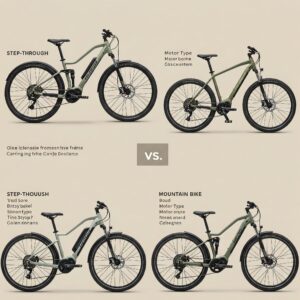
Factors to Consider When Choosing an Electric Bike Frame
Selecting the right electric bike frame involves balancing several key considerations:
Fit and Sizing
Proper frame sizing remains the most crucial factor for comfort and control. E bike frame sizing generally follows traditional bicycle measurements, but with some important differences:
✅ Standover Height – Critical for safety, especially on step-through and low-step electric bike frames
✅ Reach – Affects riding position and comfort, particularly important for longer rides
✅ Stack – Determines handlebar height relative to saddle, impacting back and neck comfort
✅ Effective Top Tube Length – Influences the stretched-out feeling while riding
Most manufacturers provide detailed sizing charts specific to their electric bike frames. Unlike traditional bicycles, many e-bikes come in fewer size options (often S, M, L rather than numeric sizes), making test riding particularly important.
Weight Capacity
Electric bike frames must support not only the rider but also the additional weight of electrical components and potential cargo:
✅ Rider Weight Limit – Check manufacturer specifications for maximum rider weight
✅ Total System Capacity – Combined limit for rider plus cargo
✅ Battery/Motor Weight – Already factored into frame design but impacts handling
✅ Additional Accessory Weight – Consider future additions like racks, fenders, or child seats
Premium electric bike frames often offer higher weight capacities, with some cargo-specific models supporting combined weights of 400+ pounds.
Intended Use and Terrain
Be realistic about your primary riding environment when selecting an electric bike frame:
🏙️ Urban/Commuting – Prioritize step-through accessibility and integrated security features
🏔️ Off-Road – Focus on suspension integration and durability
🛣️ Touring/Distance – Look for comfort-oriented geometry and multiple battery options
🏎️ Performance/Speed – Consider aerodynamic frame designs and lightweight construction
Most riders find that electric bike frames designed specifically for their intended use offer the best overall experience, even if they occasionally venture into different terrain.
Integration Quality
The seamlessness of component integration dramatically impacts the electric bike ownership experience:
✅ Cable Management – Clean internal routing protects connections and improves aesthetics
✅ Battery Removal – Consider how easily you can access the battery for charging or replacement
✅ Control Systems – Evaluate the integration of displays, controllers, and user interfaces
✅ Serviceability – Some highly integrated frames can complicate routine maintenance
Manufacturers like Specialized, Bosch-equipped bikes, and Shimano STEPS systems typically offer well-executed integration between frame and electrical components.
Frame Warranty
Electric bike frames should include robust warranty coverage:
✅ Length of Coverage – Quality frames typically offer 3-5 year warranties, with some premium brands offering lifetime coverage
✅ Electrical Integration – Check if frame-integrated electrical components have separate warranty terms
✅ Transferability – Some warranties only apply to original purchasers
✅ Crash Replacement – Many brands offer discounted replacement frames after accidents
Future Compatibility
Consider how adaptable the frame will be as technology evolves:
✅ Battery Upgradability – Can newer, higher-capacity batteries be fitted in the future?
✅ Motor Compatibility – Is the frame tied to a specific motor system that might become obsolete?
✅ Standards Compliance – Frames using industry-standard measurements for headsets, bottom brackets, and dropouts will be easier to maintain long-term
Top Electric Bike Frame Recommendations
Based on extensive research and industry expertise, here are our top recommendations for electric bike frames across different categories:
Best Overall Electric Bike Frame
Trek Allant+ 9.9S
This premium aluminum frame with carbon fiber elements represents the pinnacle of urban electric bike design. The frame features:
- Sleek internal cable routing
- Fully integrated Bosch PowerTube battery
- Removable integrated display
- Thoughtful accessory mounting points
- Available in both traditional diamond and step-through variants
The Allant’s frame geometry balances speed and comfort perfectly, making it versatile enough for fitness rides and daily commuting alike. While the premium price point ($5,999 complete) puts it beyond many budgets, the frame’s integration quality sets a standard for the industry.
Best Value Electric Bike Frame
This thoughtfully designed aluminum frame delivers premium features at a mid-range price point:
- Internal cable routing
- Integrated battery system
- Mid-drive motor mounting
- Available in step-through or crossbar designs
- Rack and fender compatibility
At $2,295 for the complete bike, the Prodigy’s frame quality and design approach rivals models costing significantly more. The frame uses hydroformed aluminum tubing to achieve an aesthetically pleasing appearance while maintaining structural integrity under power.
Best Electric Mountain Bike Frame
This purpose-built electric mountain bike frame features:
- Full carbon fiber construction (in higher models)
- Proprietary motor integration system
- Internal battery with side-access door
- Adjustable geometry
- Progressive suspension design
The Turbo Levo frame represents the cutting edge of electric mountain bike design, with geometry and suspension kinematics specifically optimized around the additional weight and power of electric assistance. The frame’s battery integration allows for easy removal while maintaining clean lines.
Best Folding Electric Bike Frame
This ingeniously designed folding electric bike frame offers:
- Robust hinge mechanism rated for heavy riders
- Bosch mid-drive motor integration
- Adjustable stem and seatpost for multiple rider sizes
- Rear rack integration into the frame structure
- Compact folded footprint
The Vektron’s frame represents a significant engineering achievement, maintaining ride quality and stability while incorporating both electric components and folding mechanisms. The frame’s design allows it to fold to a compact 41×86×68 cm package despite accommodating a full-size riding position.
Best Cargo Electric Bike Frame
This specialized cargo electric bike frame features:
- Compact wheelbase despite extended carrying capacity
- Low center of gravity design
- Massive 440 lb total capacity rating
- Multiple battery mounting options
- Adjustable for riders 4’11” to 6’5″
The GSD’s frame employs smaller 20″ wheels and clever geometry to create a cargo bike that handles like a standard bicycle despite its impressive carrying capacity. The frame’s design accommodates dual battery systems for extended range under heavy loads.
✨ Ready to Experience the Perfect Electric Ride? 🚀
➡ Transform your cycling journey with the ideal electric bike frame today! Our detailed guide has equipped you with expert knowledge to make an informed choice. Don’t compromise on quality, comfort, or performance—click on any of our recommended models to check current pricing and find your perfect match. Your ultimate electric biking adventure awaits!
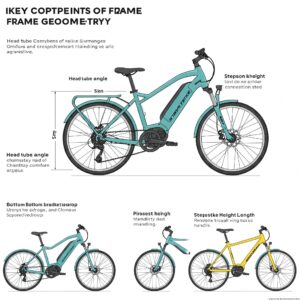
How to Maintain Your Electric Bike Frame
Proper maintenance ensures your electric bike frame will provide years of reliable service:
Cleaning Best Practices
Caring for an electric bike frame requires special attention to electrical components:
✅ Gentle Washing – Use a damp cloth rather than high-pressure water, which can penetrate seals
✅ Connection Points – Pay extra attention to cleaning areas where cables enter the frame
✅ Drying Thoroughly – Carefully dry all frame sections, particularly around electrical connections
✅ Battery Contact Cleaning – Gently clean battery contact points with a dry cloth
❌ Avoid Harsh Chemicals – Strong degreasers can damage electrical insulation and paint
Inspection Routine
Regular checks can identify potential issues before they become serious problems:
✅ Frame Cracks – Regularly inspect high-stress areas like the bottom bracket, head tube, and dropouts
✅ Battery Mount Security – Check that battery mounting systems remain tight and secure
✅ Cable Entry Points – Ensure rubber grommets and seals remain intact around cable ports
✅ Motor Mount Bolts – Verify that motor mounting hardware remains properly torqued
✅ Dropout Alignment – Particularly important for rear hub motor systems
When to Seek Professional Service
Some frame-related issues require specialized attention:
✅ Unusual Noises – Creaking or cracking sounds may indicate frame stress
✅ Electrical Intermittency – Problems with power delivery could indicate internal wiring issues
✅ Post-Crash Inspection – Always have the frame professionally inspected after significant impacts
✅ Battery Mounting Problems – Issues with battery attachment require immediate attention
✅ Alignment Concerns – Any signs of misalignment should be professionally evaluated
Storage Recommendations
Proper storage extends electric bike frame life:
✅ Indoor Storage – Keep your e-bike protected from extreme temperatures and moisture
✅ Battery Considerations – Follow manufacturer recommendations for battery storage
✅ Weight Distribution – Store in a position that doesn’t stress the frame unnaturally
✅ Cleaning Before Storage – Always clean the frame before extended storage periods
DIY vs. Professional Frame Selection
Understanding when to seek expert advice can make the difference between a perfect match and an expensive mistake:
When to Trust Professional Fitting
Some scenarios particularly benefit from professional assistance:
✅ Unusual Body Proportions – If you have especially long legs, short torso, or other unique proportions
✅ Previous Comfort Issues – If you’ve experienced pain or discomfort on standard bicycles
✅ Performance Priorities – When seeking maximum efficiency or specific handling characteristics
✅ Medical Considerations – Back problems, joint issues, or other health concerns that affect riding position
Self-Assessment Techniques
When selecting an electric bike frame independently:
✅ Online Sizing Calculators – Utilize manufacturer-provided sizing tools with your measurements
✅ Test Rides – Nothing replaces actually riding the specific frame model
✅ Reference Current Bikes – Compare geometry charts to bicycles you find comfortable
✅ Adjustability Assessment – Consider how much adjustment range the frame offers in stem and seatpost
The Importance of Test Rides
Always attempt to test ride before purchasing when possible:
✅ Handling Characteristics – How does the frame respond to steering inputs?
✅ Stability Under Power – Does the frame feel stable when the motor engages?
✅ Comfort Assessment – Pay attention to contact points and riding position
✅ Clearance Check – Ensure adequate standover and toe clearance
✅ Hill Performance – Test how the frame handles on inclines if possible
The Future of Electric Bike Frame Design
The electric bike frame market continues to evolve rapidly with several exciting trends:
Emerging Material Technologies
New frame materials and construction techniques are expanding possibilities:
🔬 Graphene-Enhanced Composites – Adding graphene to carbon fiber can increase strength while reducing weight
🔬 3D-Printed Components – Allowing for complex frame nodes and custom geometries
🔬 Recycled Carbon Fiber – More sustainable approaches to composite frame construction
🔬 Advanced Aluminum Alloys – New formulations offering improved strength-to-weight ratios
🔬 Biodegradable Materials – Experimental natural composites for more sustainable manufacturing
Smart Integration Trends
The next generation of electric bike frames will feature enhanced connectivity:
📱 Built-in Tracking Systems – GPS and cellular connectivity embedded within frame tubes
📱 Integrated Diagnostic Systems – Self-monitoring frames that alert riders to potential issues
📱 Adaptive Geometry – Electronically adjustable frame elements for changing conditions
📱 Embedded Lighting – LED systems built directly into frame tubes for enhanced visibility
📱 Theft Prevention – Smart locking mechanisms integrated into the frame structure
Customization Possibilities
The market is moving toward more personalized frame options:
🛠️ 3D Body Scanning – Custom frames based on precise body measurements
🛠️ Modular Designs – Frames with interchangeable components for changing needs
🛠️ Limited Production Runs – Boutique manufacturers offering unique frame designs
🛠️ Adaptive Components – Frames that accommodate different wheel sizes or riding positions
🛠️ Personalized Graphics – Factory-applied custom finishes and graphics packages
Custom vs. Production Electric Bike Frames
Understanding the tradeoffs between mass-produced and custom-built electric bike frames:
Benefits of Custom Electric Bike Frames
For some riders, custom frames offer significant advantages:
✅ Perfect Fit – Tailored precisely to your body proportions
✅ Specific Feature Integration – Built around your exact component preferences
✅ Unique Aesthetic – Distinctive appearance sets your bike apart
✅ Material Selection – Choose exactly the tubing and construction method
✅ Personal Relationship – Direct communication with the frame builder
Drawbacks of Custom Options
Custom isn’t always better for electric bikes:
❌ Significantly Higher Cost – Expect to pay 2-3x more than production frames
❌ Limited Integration Experience – Many custom builders have less experience with e-systems
❌ Longer Wait Times – Often 6-12 months from order to delivery
❌ Warranty Concerns – Sometimes less comprehensive than major manufacturers
❌ Resale Challenges – Custom frames can be harder to sell when upgrading
Notable Custom Electric Bike Frame Builders
Several respected builders have embraced electric assistance:
🏆 Sage Titanium – Specializing in titanium electric bike frames with exceptional attention to detail
🏆 Moots – Offering titanium e-bike frames with internally routed wiring systems
🏆 Enigma – UK-based titanium frame specialists with growing e-bike expertise
🏆 Co-Motion – Known for touring-oriented electric bike frames with S&S couplers for travel
✨ Elevate Your Electric Riding Experience Today! ⚡
➡ Ready to transform your riding experience with the perfect electric bike frame? The models we’ve discussed represent the pinnacle of modern e-bike engineering, combining innovative design with practical functionality. Whether you’re commuting, trail riding, or touring, the right frame makes all the difference in comfort, performance, and enjoyment.
Click on any of the highlighted product recommendations to check current pricing and availability—these carefully selected options offer exceptional value and quality in their respective categories! Don’t settle for an electric bike that doesn’t perfectly match your riding style and needs.
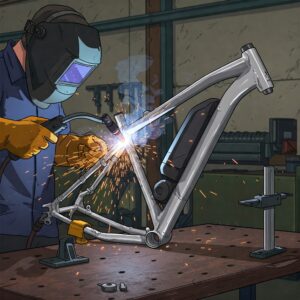
Budget Considerations for Electric Bike Frames
Understanding the cost factors that influence electric bike frame pricing:
What Drives Frame Costs?
Several factors contribute to the wide price variation in electric bike frames:
💰 Material Selection – Carbon fiber frames typically cost 2-3x more than aluminum equivalents
💰 Manufacturing Location – Frames produced in Europe or North America generally command premium prices
💰 Production Volume – Mass-produced frames benefit from economies of scale
💰 Integration Complexity – More sophisticated battery/motor integration increases costs
💰 Brand Premium – Established brands often charge more for similar specifications
Value-Oriented Frame Recommendations
Quality electric bike frames don’t always require premium pricing:
🏆 REI Co-op CTY e2.1 – Well-designed aluminum frame with clean integration at $1,799
🏆 Ride1Up Core-5 – Straightforward frame design with thoughtful battery integration at $1,095
🏆 Lectric XP 3.0 – Folding frame with surprising durability and function at $999
🏆 Aventon Pace 350 – Clean frame design with internal battery and quality welds at $1,399
Price-to-Performance Sweet Spot
For many riders, mid-range frames offer the best balance of quality and affordability:
💰 $1,500-$2,500 Range – Typically features hydroformed aluminum frames with internal battery integration
💰 $2,500-$4,000 Range – Higher-grade aluminum with more sophisticated motor integration and lighter weight
💰 $4,000+ Range – Carbon fiber options become available, with premium integration and design details
Environmental Impact of Electric Bike Frames
As sustainability becomes increasingly important, understanding the environmental implications of different frame materials helps conscientious consumers:
Carbon Footprint Comparison
Different frame materials have varying environmental impacts:
🌱 Aluminum – Energy-intensive production but highly recyclable
🌱 Carbon Fiber – Significant production footprint and challenging to recycle
🌱 Steel – Lower production energy but heavier (requiring more battery power)
🌱 Titanium – High initial impact but extremely long lifespan
🌱 Magnesium – Potentially lower impact but less established recycling infrastructure
Sustainability Initiatives
Several manufacturers are addressing environmental concerns:
♻️ Specialized – Investing in carbon fiber recycling technology
♻️ Trek – Carbon Care program for responsible disposal of carbon frames
♻️ Riese & Müller – Focus on longevity and serviceability to extend product life
♻️ Brompton – Emphasis on space-efficient transportation and multimodal commuting
♻️ VanMoof – Urban-focused designs promoting car replacement
Longevity Considerations
The most sustainable frame is often one that lasts for many years:
🕒 Serviceability – Frames with standard specifications remain serviceable longer
🕒 Upgrade Pathways – Designs that accommodate newer components extend useful life
🕒 Corrosion Resistance – Materials and finishes that withstand environmental exposure 🕒 Structural Durability – Overbuilt frames may be heavier but offer longer service lives
Common Electric Bike Frame Issues and Solutions
Understanding potential problems can help you avoid issues or address them quickly:
Battery Mount Failures
One of the most critical potential failure points:
🔧 Symptoms – Loose battery, intermittent power loss, rattling sounds
🔧 Prevention – Regular inspection of mounting hardware, gentle handling when removing battery
🔧 Solutions – Replacement mounting hardware, frame manufacturer warranty service
🔧 Design Evolution – Newer frame designs typically feature more robust mounting systems
The Bosch PowerTube battery system used in many premium frames has established a reputation for reliable mounting, while some budget models may experience issues over time.
Cable Routing Problems
Internal routing can sometimes create challenges:
🔧 Symptoms – Intermittent electrical connection, control system errors, difficult shifting
🔧 Prevention – Careful handling during maintenance, avoiding sharp bends in cables
🔧 Solutions – Professional re-routing, cable replacement, updated grommets or guides
🔧 Design Improvements – Fully guided internal routing systems becoming more common
Motor Mount Issues
Critical structural area requiring attention:
🔧 Symptoms – Creaking sounds, power loss, visible movement at motor mount
🔧 Prevention – Regular bolt checks, avoiding extreme torque conditions
🔧 Solutions – Professional torque verification, thread locker application, manufacturer warranty
🔧 Engineering Progress – Integrated motor mounts replacing bolt-on systems in newer designs
Frame Fatigue and Failure Points
Understanding where problems typically develop:
🔧 Head Tube Junction – High stress area, particularly on aluminum frames
🔧 Bottom Bracket Shell – Critical area subject to pedaling and motor forces
🔧 Seatpost Cluster – Especially important on full-suspension frames
🔧 Dropouts – Particularly stressed with rear hub motors
🔧 Folding Mechanisms – Hinges and latches on folding frames require regular inspection
Legal and Regulatory Considerations
Electric bike frames must comply with various regulations depending on region:
Classification Compliance
Electric bike frames are designed to accommodate specific motor and speed capabilities:
📋 Class 1 – Frames designed for pedal-assist only, up to 20 mph
📋 Class 2 – Includes throttle capability, up to 20 mph
📋 Class 3 – Pedal-assist up to 28 mph
📋 International Variations – European frames often limited to 25 km/h support
Safety Standards
Quality electric bike frames conform to industry testing standards:
📋 ISO 4210 – International standard for bicycle safety
📋 EN 15194 – European standard specific to electric bicycles
📋 UL 2271/2272 – Standards for battery systems often influencing frame design
📋 Manufacturer-Specific – Many brands conduct additional proprietary testing
Warranty Implications
Understanding how frame design affects warranty coverage:
📋 Integrated Components – Often covered under separate warranty terms
📋 Modification Impact – Changes to frame or electrical systems typically void warranties
📋 Transferability – Some premium frame warranties apply only to original owner
📋 Commercial Use – Many warranties exclude commercial applications
✨ Ready to Experience the Perfect Electric Ride? 🚀
➡ Transform your cycling journey with the ideal electric bike frame today! Our detailed guide has equipped you with expert knowledge to make an informed choice. Don’t compromise on quality, comfort, or performance—click on any of our recommended models to check current pricing and find your perfect match. Your ultimate electric biking adventure awaits!

Conclusion
The electric bike frame forms the foundation of your entire riding experience, influencing everything from comfort and performance to longevity and value. As we’ve explored throughout this comprehensive guide, the perfect electric bike frame balances several critical factors: material selection, integration quality, geometry, and intended use case.
For most riders, aluminum frames with thoughtful battery integration represent the sweet spot of performance and value, while those seeking maximum performance might justify the premium for carbon fiber construction. Step-through designs continue to gain popularity across all riding categories for their accessibility and convenience, while diamond frames maintain their edge in maximum stiffness-to-weight performance.
As electric bike technology continues to evolve, we’re seeing increasingly sophisticated frame designs with smarter integration, improved aesthetics, and enhanced functionality. The distinction between electric bikes and traditional bicycles is becoming more pronounced as manufacturers develop purpose-built frames that optimize the unique characteristics of electric assistance rather than simply adapting conventional designs.
Whether you’re shopping for your first electric bike or considering a frame upgrade, understanding the nuances of electric bike frame design will help you make an informed decision that enhances your riding experience for years to come. The perfect e bike frame isn’t necessarily the most expensive or the lightest—it’s the one that best matches your specific riding needs, body proportions, and performance expectations.
More FAQs
❓ What is the best material for an electric bike frame?
✅ Aluminum alloy is generally considered the best all-around material for most electric bike frames, offering excellent strength-to-weight ratio at reasonable cost... Carbon fiber provides superior weight savings but at significantly higher prices, while steel offers exceptional durability with a weight penalty...
❓ How much do electric bike frames typically weigh?
✅ Electric bike frames typically weigh between 6-12 pounds for aluminum frames and 4-8 pounds for carbon fiber frames... Complete e-bikes range from 40-70 pounds total weight depending on battery size, motor type, and accessories...
❓ Can I upgrade my regular bike frame to an e bike frame?
✅ Converting a standard bike frame to electric is possible but often compromises integration quality... Purpose-built electric bike frames feature reinforced areas for motor mounts, internal battery compartments, and cable routing specifically designed for electrical components...
❓ How long do electric bike frames typically last?
✅ Quality electric bike frames can last 5-10 years or more with proper care... Aluminum frames typically have shorter fatigue life than steel or titanium but remain durable for normal use patterns. Premium carbon frames can last indefinitely if not damaged...
❓ Are folding electric bike frames as durable as standard frames?
✅ Well-designed folding electric bike frames from reputable manufacturers are engineered to be nearly as durable as standard frames... They incorporate reinforced hinge mechanisms and locking systems rated for the additional weight of electrical components. Higher-end models use specialized tubing to maintain strength despite the folding capability...
Recommended for You:
- 10 Best Ebike Frame Options for Ultimate Performance in 2025
- 10 Best Electric Bike Motor Options For Ultimate Performance in 2025
- 10 Brilliant Ebike Lights That Will Make You Love Night Riding in 2025
Disclaimer: This article contains affiliate links. If you purchase products through these links, we may earn a small commission at no additional cost to you.
✨ Found this helpful? Share it with your friends! 💬🤗
